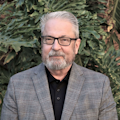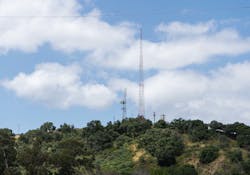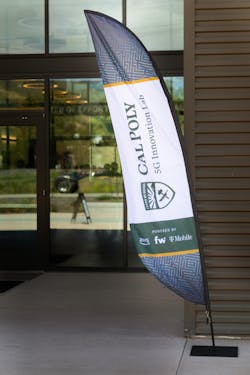T-Mobile, AWS, Federated Wireless & Neutral CBRS Host, Launch Cal Poly’s 5G Private Network
“Introducing a 5G private network to Cal Poly meets three important needs: improving campus operations, enhancing core IT services, and connecting faculty and students in collaboration with faculty and partners.”—Jeffrey D. Armstrong, President, Cal Poly
The challenge facing California Polytechnic State University (Cal Poly), an institution known for its Learn by Doing philosophy, was an immediate need to enhance its connectivity. Cal Poly sought a network solution that would optimize safety, communication, and research potential for its student and staff community. T-Mobile, a key partner in the endeavor, had to ensure its customers enjoyed the best experience possible, particularly in areas traditionally hard to reach for cell signals.
The answer to those pain points lay in collaboration. The key was using a wireless communication hub that integrated AWS Snowball Edge and AWS Snowcone services to support a multi-use private wireless network. Neutral hosting of the Citizens Broadband Radio Service (CBRS) band has emerged as a robust solution to address connectivity requirements, opening doors for academic innovation and seamless communication.
This convergent 4G and 5G technology utilized the CBRS band, a public-access, shared-spectrum model. Unlike legacy neutral host technologies requiring differing configurations for each Mobile Network Operator (MNO), the Neutral Host 2.0™1 used an open, shared solution, thus eliminating the need for complex MNO-specific configurations.
The deployment of this solution started in remote hiking areas and the William and Linda Frost Center for Research and Innovation at Cal Poly. The private wireless network supported both private connectivity services provided by the university, and connectivity for T-Mobile subscribers, demonstrating an effective model of public-private network interoperability.
Enhanced connectivity and safety across the campus were achieved by leveraging the 4G neutral host over CBRS, thereby boosting the coverage experience in places like the Frost building and outdoor areas on remote hiking trails. The system's capabilities ensured students could make 911 calls in case of emergency, even from the most remote corners of the campus. Unmetered broadband streaming provided students the ability to securely stream class videos and other content over the private wireless network via self-provisioned mobile devices with an embedded subscriber identity module (eSIM).
High-speed, ultra-low-latency 5G connectivity opened new vistas for advanced research supporting next-gen use cases such as 3D image capture and augmented reality to manage the progress of site construction projects.
According to Sameer Vuyyuru, Director and Head of Worldwide Telecommunications Business Development at AWS, “Many buildings, such as those that are built with metal or concrete, or are LEED-certified, leverage building materials that can block cell signals inside the building. Signals can also be blocked by geographical landscapes, which impacts coverage and creates dead zones. A neutral host solution runs along with the private network on AWS edge compute, while a CBRS Spectrum Access System runs on AWS, providing an innovative, versatile, scalable, and low-CAPEX approach for building owners, campuses, and facilities to work with wireless providers to enhance coverage.”
The combined efforts of Cal Poly, T-Mobile, AWS, and the neutral host partner, serve as a practical blueprint for addressing complex business challenges and exemplify the power that shared spectrum and an open ecosystem model can bring to higher education and private enterprise.
“Unmetered broadband streaming provided students the ability to securely stream class videos and other content over the private wireless network via self-provisioned mobile devices with an embedded subscriber identity module (eSIM).”
The Cal Poly project embraces shared spectrum, shared radio networks, and a standards-based interoperable ecosystem. This open ecosystem breaks down vendor silos, bridging the gap between public and private wireless. The framework significantly reduces cost barriers typically associated with vendor-specific models. The blend of technologies equips clients with superior private wireless capabilities and public cellular connectivity in previously unconnected indoor and outdoor areas. This is done by leveraging CBRS to efficiently power a single radio network that can be simultaneously used by multiple MNOs. This is a major departure from the more expensive, legacy Distributed Antenna System (DAS) neutral host systems which needed separate radios to support different licensed spectrums for each MNO.
Mark McDiarmid, SVP, Technology Innovation and Industry Partnerships at T-Mobile, shares, “At T-Mobile, we want to make sure all our customers—both business and consumer—have the best experience possible. To help Cal Poly enhance coverage, we were able to use neutral host capability to quickly layer T-Mobile service onto Cal Poly’s existing private wireless network, providing our subscribers with an optimal, game-changing network experience on campus.”
This open ecosystem approach promotes the breakdown of vendor silos by merging the best 5G solution components based on customers’ use-case needs. This strategy effectively negates the restrictions of vendor lock-in so customers can use their private wireless network to provide public cellular access as needed.
The resulting converged network brings to life the vision of Cal Poly’s CIO and Vice President for IT services, Bill Britton. Britton explained, “The wireless communications world is on the edge of exciting and beneficial advancements, and the innovative capabilities around private 5G, Wi-Fi 6E, and commercial 4G/5G are expansive.
Through our partnership with experts in the 5G space, the Cal Poly 5G Innovation Lab will answer questions about reducing wireless access points, providing wireless coverage in hard-to-reach areas, keeping secure transactions on a private network, designing, and operating digital twins, and improving remote search and rescue as just a few of the examples to be explored.”
REFERENCES AND NOTES
1. Neutral Host 2.0™, https://www.federatedwireless.com/products/neutral-host/?utm_source=publication&utm_medium=referral&utm_campaign=neutral-host-ISE
About the Author

William J. Britton
William J. “Bill” Britton is the Vice President of Information Technology and Chief Information Officer (CIO) at Cal Poly, and Director of the California Cybersecurity Institute. As chief technologist, he’s responsible for managing the university’s information technology enterprise, while also building the California Cybersecurity Institute into a nationally-prominent education and research facility. Throughout his career, Britton has worked to research, develop, and implement new technologies. From the inception of “cyber,” he has been on the forefront of developing new cybersecurity concepts.

